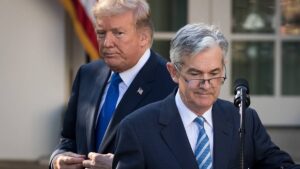Europe’s war is India’s boom… and being in the middle is terrific until the shooting breaks out

NEW DELHI, INDIA - OCTOBER 31: Ricky Ponting and Matthew Hayden of Australia lie on the ground along with the Indian players and umpire Billy Bowden as a swarm of bees pass over the ground during day three of the Third Test match between India and Australia at the Feroz Shah Kotla Stadium on October 31,2008 in New Delhi,India. (Photo by Michael Steele/Getty Images)
India’s on a roll, the Reserve Bank of India declared, in its unusually upbeat annual report on the state of the nation, and it’s only beginning to gather momentum.
American incompetence – see the regional banks or the government bills; China’s economic recovery is not recovering and Europe’s war – looking longer, bloodier and even more meaningless are all adding lustre to the recent Indian economic enlightenment.
S&P Global Ratings retained India’s GDP growth forecast at 6 per cent calling it the fastest growing economy among Asia Pacific nations. In its quarterly economic update for Asia-Pacific, S&P Global Ratings forecasted the same growth for Vietnam and the Philippines alongside India on Monday.
In its latest report, S&P has kept the GDP growth forecast for India unchanged for the current and the next fiscal, FY25 partly on account of domestic resilience.
A new confidence at home, and some fortuitous fence sitting in Europe have contributed to India’s boom… but being everyone’s best mate can also mean being no one’s friend when the punching starts.
Indian ties to the Kremlin have been tight since forever. The Soviet Union helped India set up steel mills and power plants, backed their space ambitions and went all the way when it came to sharing nuclear technology.
If the Indian military-industrial complex looks a little Ruski, that’s because .some two-thirds of India’s military equipment was first conceived in the Motherland.
And despite seeking a more martial alliance with the West, including us and the big US, India just keeps coming back for more of the Russian stuff.
India is touting Russia’s S-400 air defence system. Pretty ordinary, if what’s happening in Ukraine is any indication.
Russia’s been renting out a nuclear-powered submarine, which Delhi likes to take out for a spin, though considering what happened the other week near the Tutanic, they’d do well to stay close (or far) from Bombay.
Perhaps most dubiously, the Russian AK 203 assault rifles used to kill Ukrainians are manufactured in India.
The global economy and its regular big name nations might be having trouble finding first gear so far in 2023, but meanwhile in India, according to the normally reticent Reserve Bank of India (RBI), the world’s most populous country is staring down a long road of sustained growth.
And like all the best flavoured expansions, it’s being domestic-led. But it does have a strong whiff of Borsch to it as well.
By not joining the west in flat out condemning Russia for the Ukraine conflict, Modi has maintained what Putin also calls – “the Special and Privileged Strategic Partnership.”
The bilateral trade target has been set at US$50 billion this year and it looks a show-in.
With war dribbling out the front pants in Moscow, India didn’t flinch before accepting the idea of a Rupee-Ruble exchange system. And since since January this year, Russia quickly became India’s top oil supplier, replacing Iraq and doing it at mates rates, usually reserved for mates like China.
It’s not all beer and skittles though, the RBI says.
There’s the big question mark of an unwelcome El Niño potentially wreaking some havoc on rainfall, food production and prices – but a bit of easing inflation, solid local demand, a few structural reforms and some genuine economic momentum have been the major takeouts from the central bank’s almost celebratory annual report.
Last month, Vincent Mortier Group Chief Investment Officer at the €2 trillion French asset management company, Amundi, said the pace, variety and consistency of India’s recent economic success is changing long-held attitudes on India’s risk-reward thesis, with more investors now warming to the idea of India becoming a pillar of global growth.
Mortier, who runs the investment team at Europe’s largest asset manager – and one of the 10 biggest investment managers in the world – said that despite all the recent market turmoil – and the often volatile nature of Indian politics, the country finds itself ideally placed in the tectonic divides splitting the globe across East and West in 2023.
“In spite of its domestic woes, India’s influence in the geopolitical arena is likely to strengthen, as it has maintained relationships with various powers and is benefitting from the Western resolve to disentangle itself from China.
The central bank probably couldn’t put it better. At home, inflation is already moderating and the various tempests shaking global markets, only arrive in Delhi as a slight breeze.
The US debt ceiling, the war in Ukraine, the geopolitical divides, resurgent financial market volatility – the doubts around US banks, might pose downside risks all-round, but this time India is looking like the safest port almost anywhere.
The books are solid, the external account has real depth and the Reserve Bank of India (RBI) says the country’s rarely looked this resilient
“Domestic economic activity does face challenges from an uninspiring global outlook going forward, but resilient domestic macroeconomic and financial conditions, expected dividends from past reforms and new growth opportunities from global geo-economic shifts place India at an advantageous position.”
India’s contribution to global growth – on average – over the past 5 years., according to the IMF is no less than 12%.
In real GDP terms, this financial year India’s already looking a economic growth of over 7%.
“The crowding-in effects of sustained increase in government capex over recent years is expected to spur higher private investment in 2023-24,” the central bank said.
It’s definitely cricket
There’s several opportunities for foreign investors looking to gain exposure to India, Amundi told clients last week.
“Looking at equities, India’s long-term growth story is appealing beyond its short-term valuation excess and is supported by improved bank balance sheets, sound corporate balance sheets, leaner cost structures, policy reforms and Production-Linked Incentives (PLI).”
Vincent Mortier says India’s macro fundamentals are “well positioned for a multi-year improvement in economic output and earnings.”
“Beyond the long-standing strength of its demographics, urbanisation and rising middle class, new factors are emerging that will accelerate investment opportunities in the country
Indian corporates have also deleveraged he adds, and some of these maturing giants now sit on strong balance sheets, while Indian banks have strong capital adequacy ratios, and the government of Narendra Modi has “plugged loopholes” in the real estate sector.
“Future policy efforts should focus on green-field investments in newer sectors and industries and should propel the growth of corporate capital expenditure which has lagged in the past decade.”
Fixed to neutral
Meanwhile India’s fixed income yields “remain attractive both on a relative and an absolute basis” and getting in on those is apparently worth the effort, Amundi believes.
“Although India’s inclusion in global bond indices has been hindered, there are several routes investors can follow to enter the bond market.
“The Fully Accessible Route (FAR) remains the best for gaining exposure to Indian government securities, whereas the Voluntary Retention Route (VRR) is preferred for corporate bond investments. India’s green bond market is also rapidly growing to include public sector organisations, state-owned commercial banks, corporates and the banking sector, with US$7.45bn issued to date.”
Finally, the long lambasted Indian rupee now looks and feels more stable and should be able to squeeze out some cheap runs against the majors on a pitch less favourable to a weakening US dollar. Despite the uncertainty, FX traders expect 2023 could even be a better year for the rupee than last year.
On the whole there’s growing agreement that the next decade could be all about India.
But there are risks – as ever – which need to be fully appreciated. Indian politics and government policy can often detach themselves from the safest course. Commodity prices can weight heavily.
On the plus side of that, India’s crude oil imports from Russia surged to an all-time high in May 2023 to 2 million barrels a day. That’s cheap oil and it buys India leverage and influence at the same time.
As can food prices and the extraneous variables which impact those. India’s mates with everyone right now, except it’s economically larger and angrier neighbour China.
In fact India’s very geopolitical neutrality may yet come back to bite it – once the pushing comes to shoving being right in the middle isn’t necessarily the safest place.
Related Topics
UNLOCK INSIGHTS
Discover the untold stories of emerging ASX stocks.
Daily news and expert analysis, it's free to subscribe.
By proceeding, you confirm you understand that we handle personal information in accordance with our Privacy Policy.








